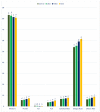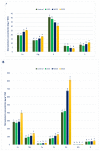Salt Eustress Induction in Red Amaranth (Amaranthus gangeticus) Augments Nutritional, Phenolic Acids and Antiradical Potential of Leaves
- PMID: 36552642
- PMCID: PMC9774578
- DOI: 10.3390/antiox11122434
Salt Eustress Induction in Red Amaranth (Amaranthus gangeticus) Augments Nutritional, Phenolic Acids and Antiradical Potential of Leaves
Abstract
Earlier researchers have highlighted the utilization of salt eustress for boosting the nutritional and phenolic acid (PA) profiles and antiradical potential (ARP) of vegetables, which eventually boost food values for nourishing human diets. Amaranth is a rapidly grown, diversely acclimated C4 leafy vegetable with climate resilience and salinity resistance. The application of salinity eustress in amaranth has a great scope to augment the nutritional and PA profiles and ARP. Therefore, the A. gangeticus genotype was evaluated in response to salt eustress for nutrients, PA profile, and ARP. Antioxidant potential and high-yielding genotype (LS1) were grown under four salt eustresses (control, 25 mM, 50 mM, 100 mM NaCl) in a randomized completely block design (RCBD) in four replicates. Salt stress remarkably augmented microelements, proximate, macro-elements, phytochemicals, PA profiles, and ARP of A. gangeticus leaves in this order: control < low sodium chloride stress (LSCS) < moderate sodium chloride stress (MSCS) < severe sodium chloride stress (SSCS). A large quantity of 16 PAs, including seven cinnamic acids (CAs) and nine benzoic acids (BAs) were detected in A. gangeticus genotypes. All the microelements, proximate, macro-elements, phytochemicals, PA profiles, and ARP of A. gangeticus under MSCS, and SSCS levels were much higher in comparison with the control. It can be utilized as preferential food for our daily diets as these antiradical compounds have strong antioxidants. Salt-treated A. gangeticus contributed to excellent quality in the end product in terms of microelements, proximate, macro-elements, phytochemicals, PA profiles, and ARP. A. gangeticus can be cultivated as an encouraging substitute crop in salt-affected areas of the world.
Keywords: A. gangeticus; ABTS+; HPLC-UV DPPH; NaCl; PA profiles; minerals; phytochemicals; protein and dietary fiber.
Conflict of interest statement
The author declares no conflict of interest.
Figures












Similar articles
-
Salinity Stress Ameliorates Pigments, Minerals, Polyphenolic Profiles, and Antiradical Capacity in Lalshak.Antioxidants (Basel). 2023 Jan 11;12(1):173. doi: 10.3390/antiox12010173. Antioxidants (Basel). 2023. PMID: 36671036 Free PMC article.
-
Polyphenol and flavonoid profiles and radical scavenging activity in leafy vegetable Amaranthus gangeticus.BMC Plant Biol. 2020 Nov 2;20(1):499. doi: 10.1186/s12870-020-02700-0. BMC Plant Biol. 2020. PMID: 33138787 Free PMC article.
-
Protein, dietary fiber, minerals, antioxidant pigments and phytochemicals, and antioxidant activity in selected red morph Amaranthus leafy vegetable.PLoS One. 2019 Dec 12;14(12):e0222517. doi: 10.1371/journal.pone.0222517. eCollection 2019. PLoS One. 2019. PMID: 31830064 Free PMC article.
-
Emerging opportunities in exploring the nutritional/functional value of amaranth.Food Funct. 2018 Nov 14;9(11):5499-5512. doi: 10.1039/c8fo01422a. Food Funct. 2018. PMID: 30307006 Review.
-
Phytochemicals in quinoa and amaranth grains and their antioxidant, anti-inflammatory, and potential health beneficial effects: a review.Mol Nutr Food Res. 2017 Jul;61(7). doi: 10.1002/mnfr.201600767. Epub 2017 Apr 18. Mol Nutr Food Res. 2017. PMID: 28239982 Review.
Cited by
-
Potassium augments growth, yield, nutrient content, and drought tolerance in mung bean (Vigna radiata L. Wilczek.).Sci Rep. 2024 Apr 23;14(1):9378. doi: 10.1038/s41598-024-60129-z. Sci Rep. 2024. PMID: 38654029 Free PMC article.
-
Nutritional and bioactive properties and antioxidant potential of Amaranthus tricolor, A. lividus, A viridis, and A. spinosus leafy vegetables.Heliyon. 2024 Apr 27;10(9):e30453. doi: 10.1016/j.heliyon.2024.e30453. eCollection 2024 May 15. Heliyon. 2024. PMID: 38720726 Free PMC article.
-
Extraction of organic pigments from tomato (Solanum lycopersicum L.), turmeric (Curcuma longa L.) and red amaranth (Amaranthus tricolor L.) for safe use in agro-products.Heliyon. 2024 Jan 24;10(3):e25278. doi: 10.1016/j.heliyon.2024.e25278. eCollection 2024 Feb 15. Heliyon. 2024. PMID: 38317892 Free PMC article.
-
Integrating BLUP, AMMI, and GGE Models to Explore GE Interactions for Adaptability and Stability of Winter Lentils (Lens culinaris Medik.).Plants (Basel). 2023 May 23;12(11):2079. doi: 10.3390/plants12112079. Plants (Basel). 2023. PMID: 37299058 Free PMC article.
-
Climate-smart rice (Oryza sativa L.) genotypes identification using stability analysis, multi-trait selection index, and genotype-environment interaction at different irrigation regimes with adaptation to universal warming.Sci Rep. 2024 Jun 15;14(1):13836. doi: 10.1038/s41598-024-64808-9. Sci Rep. 2024. PMID: 38879711 Free PMC article.
References
-
- Promising Das S. Amaranthus: A Promising Crop of Future. Springer; Singapore: 2016. Amaranths: The Crop of Great Prospect; pp. 13–48.
-
- Sreelathakumary I., Peter K.V. Genetic Improvement of Vegetable Crops. Elsevier; Amsterdam, The Netherlands: 1993. Amaranth: Amaranthus spp; pp. 315–323.
-
- Sauer J.D. The Grain Amaranths and Their Relatives: A Revised Taxonomic and Geographic Survey. Ann. Mo. Bot. Gard. 1967;54:103. doi: 10.2307/2394998. - DOI
-
- Anu R., Mishra B.K., Mrinalini S., Ameena S., Rawli P., Nidhi V., Sudhir S. Identification of Heterotic Crosses Based on Combining Ability in Vegetable Amaranthus (Amaranthus tricolor L.) Asian J. Agric. Res. 2015;9:84–94.
LinkOut - more resources
Full Text Sources
Miscellaneous

